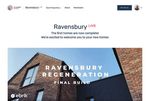Regenerating Affordable and Enabling Housing for All Ages- at Scale
←
→
Page content transcription
If your browser does not render page correctly, please read the page content below
PRINCIPLES in ACTION As we emerge from a tragic pandemic, let’s catalyze action among professionals in the fields that shape the physical housing and communities where we live. This series of case studies shares innovations that are advancing a set of guiding principles for built environment professionals—from creative ways to redress inequities and engage the public in participatory planning, to unique housing and community models that enable every resident to thrive. Students at Abbey Primary School during Clarion’s annual Regeneration Week, where young people work with architects to build models and co-design play areas in the public realm. Regenerating Affordable and Enabling Housing for All Ages— at Scale Clarion Housing Group, UK By Stephanie Firestone and Esther Greenhouse One of the UK’s largest developers, the nonprofit Clarion Housing Group (“Clarion”) believes it has a responsibility to lead from the front, driving a broad view of social value in the nation’s housing sector. Thus, Clarion’s business model includes developing private-sector, market-rate homes in order to generate profits that subsidize the addition and regeneration of social housing. The values embedded in the regenerated homes and communities are creating, for the entire industry, a model centered on both a human-centered approach as well as design that addresses demographic change and builds in resilience. aarp.org/equitybydesign
PRINCIPLES in ACTION
Needs/Challenges
Population aging and changing preferences are major issues shaping current and future needs, services, and budgets in the UK. Paul
Quinn, director of regeneration at Clarion, believes this requires a systematic, consistent, and widespread response. “Demographic
change is just as inevitable as climate change, but no one is preparing for it,” he says.
In the UK, five developers build 80 percent of the homes. Their involvement typically is limited to the two-to-five-year building
stage, meaning they have no further responsibility or connection to their buildings or residents following that brief period.
As a result, they rarely design for people’s changing needs over their lifespan, or for shifting living patterns and preferences.
Additionally, communities and households undergoing regeneration often find themselves displaced to make way for new
homes and infrastructure, disrupting individuals’ lives and the fabric of a neighborhood. In some instances, developers offer
residents a “right to return,” but the timescales often make this impractical for residents.
Innovations
As the largest housing association and landlord in the UK, Clarion owns 125,000 properties that house 350,000 people. Clarion
is a nonprofit charity, building over 2,000 new homes a year while investing in and regenerating its existing stock. Regeneration1
happens when properties are in such poor condition that they go through a review process to determine whether they should be
comprehensively refurbished, replaced entirely, or even demolished and disposed of (i.e., sell the site).
Serving its client base, which is people at the bottom 20 percent of the socio-economic strata, Clarion remains true to a mission
that has driven the work since the organization’s founding by Victorian philanthropist William Sutton over 100 years ago: to deliver
good quality and affordable homes and neighborhoods to people failed by the market. Because Clarion owns the properties, it aims
to design and build homes to have an extended life, in some cases up to 100 years, and it makes good business sense to incorporate
priorities like ease of adaptability, resilience, and a minimal need for resident relocation.
Age-Friendly Strategy
Clarion spent a year developing
and recently adopted an age- Our age-friendly
friendly strategy, which commits
to three key principles: using
commitments Design
and build
design and building schemes Our Overarching missiOn is:
Enabling people to live well in our communities.
that enable residents to live Age-friendly
longer, healthier, happier lives; strategy
ensuring residents have the Over the last 12 months, we have been collaborating as a cross-business
working group to create a set of commitments focused on how we will ensure Right home at
right home at the right time; and our communities are places where residents can age positively. the right time
empowering residents to shape
their lives and communities,
no matter what their age. They Empowering
Development Housing Clarion Futures people
are committed to this all-ages
Design and build schemes that Ensure residents have the right Empower residents to shape their lives
approach, which Clarion refers enable our residents to live
longer, healthier, happier lives.
home at the right time. and communities, no matter what age.
to as intergenerational living but To consider and establish our
Understand how life events could trigger
changes in resident needs and explore
Deliver interventions across resident
lifecycles and understand how these
position on specialist housing; ways we can prevent a negative impact. contribute to resident wellbeing.
residents know in much simpler looking at different models, levels
Make sure residents know their housing options Recognise how housing could contribute to
of subsidy and specific markets.
and concrete terms: being Ensure our developments are
and help them anticipate changes as they age. improved health outcomes for residents.
exemplars of age-friendly Better assist residents to move from Specially target a reduction in
able to live with their friends, homes and communities. one life stage to the next. loneliness and social isolation.
relatives, and neighbors in Cultivate clear design standards and
specifications for age-friendly housing.
Understand how we could flex our existing
assets to make them more age-friendly.
their community.
1
Similar to what is called in the US “renewal.”
2 AARP | aarp.org/equitybydesign © 2021 AARP. All Rights Reserved.PRINCIPLES in ACTION
At the core of Clarion’s human-centered approach is good design. Architects develop design patterns with a focus on getting
it right from the start, considering from the outset such elements as corridor widths, adjacencies, Universal Design, and
other health-supporting features, such as daylight exposure. They prioritize making spaces flexible and adaptable to lifestyle
changes; this may be as simple as “just oversizing a bit,” so a downstairs bathroom can be converted later to a wet room.
AARP | aarp.org/equitybydesign © 2021 AARP. All Rights Reserved. 3PRINCIPLES in ACTION
Adaptability + Customization
Quinn’s view is that 90 percent of Clarion’s work is the face-to-face interaction with people—that is, understanding and
supporting their needs. The Regeneration team engages directly with residents during the planning phase—ascertaining
every individual household’s needs, aspirations and concerns—and throughout the regeneration process. The team
reviews the needs of each resident based on their mobility, any disabilities, concerns about decline, and an assessment
by an occupational therapist. All these considerations inform customized home designs that will support the residents’
abilities and enable them to be as independent as possible. When they move out, the residence is modified for the new
resident, if necessary.
During construction, resident engagement
is augmented through the use of the
construction-site technology platform
eBrik. Beyond enabling Clarion to better
monitor the site and communicate with
contractors, eBrik is made available to
residents, so for example, when it is
time to select appliances, residents can
view the options in the context of their
new home. From foundation laying to
move-in, the eBrik system maintains
resident engagement and keeps morale
high throughout a process that takes two
or more years to complete. For all these
benefits and with a cost of only £30,000
(approximately $42,000), Clarion is now
embedding this technology and approach
in all of their regeneration projects.
Blacksmiths Lane in Bromley, London, is Clarion’s first site to include age-friendly design principles from the outset. The
design team (led by Fielden Clegg Bradley) is undertaking a feasibility study of a 150-home site, where they intend for both
homes and the community as a whole to be designed for multigenerational living. In addition to homes that work for all,
irrespective of age or mobility, the homes will offer ease of operation and adaptation for changing needs, thus building
resilience into the homes and making adaptations cost-effective.
4 AARP | aarp.org/equitybydesign © 2021 AARP. All Rights Reserved.PRINCIPLES in ACTION
In Ravensbury, Clarion will demolish and replace all the homes. While the planning predates the more recent age-friendly
strategy, it reflects a kernel of interest in that approach. Larger, two-story units can be subdivided into smaller spaces
and flex as needs change: stairwells are designed to accommodate stair-lifts and the dining room can become a ground-
floor bedroom. The homes are orientated to allow and encourage social connectedness; they also sit on short streets
with green spaces nearby that provide opportunities for community stewardship. The block specifically designed for
older adults does so discretely; elevators and stairwells have slightly more width and space to allow for easier adaptation
if needed, without suggesting vulnerability. This adaptability addresses another major housing trend present in several
developed countries—the increasing need for one- and two-bedroom housing units, reflecting a rapid rise in the number
of single person households; much of the existing housing supply does not match this demand.
Regenerating Ravensbury
• Flexible and adaptable homes;
• More space for future needs;
• More light;
• Easier to keep warm—affordable;
• Generous private and shared amenity;
• Community facilities.
A Focus on Community
There is a heavy investment in maintaining and supporting community in every project. This priority is partly reflected
in design principles, such as Jane Jacobs’ tenet that spaces that work, perhaps counterintuitively, are spaces that are
overlooked. At Ravensbury, for example, flood risk demanded the need for exterior steps, which designers seized as an
opportunity to further engender connectedness: they incorporated oversized steps based on New York City’s front-stoop
model, creating another space for people to inhabit, engage, and be part of the community (while also providing on-level
access, usually through a rear ramp). Quinn contends that developers must think early on about elements to encourage
social connectedness, because “you can’t retrofit this stuff.”
Putting people and community first also means keeping residents together and avoiding their displacement. One way this is
done is by limiting resident disruption to only one move—once their new, permanent homes are ready for them. Sometimes
this necessitates purchasing sites near or even adjacent to their current homes, in order to build the new homes before
moving residents and then demolishing the old ones. Clarion recognizes that they could move people off site and rebuild in
half the time—but at the cost of community.
AARP | aarp.org/equitybydesign © 2021 AARP. All Rights Reserved. 5PRINCIPLES in ACTION
Successes to Date New sites currently in the feasibility stage will incorporate
an intergenerational living approach. Clarion included
Clarion employs architects to develop practical designs
experience with this approach in its scoring rubric for selecting
that have been and will increasingly be used in upcoming
contractors (the design team in particular) and is running
developments. The first 21 Ravensbury homes that include some
relevant workshops as part of the design process.
intergenerational design elements are built, with another 50
underway in September. These homes serve not only as a model Clarion’s new 2040 Standard demands a higher threshold
for how Clarion is increasingly building, but also as pilots for in areas such as environmental performance, the quality of
learning and tweaking the master plan for Ravensbury (which the public realm, safety, crowding, and strategic location
will be delivered in four phases) and continually improving the for affordable homes. All new and existing Clarion homes
design from an intergenerational perspective. will need to meet these standards, including necessary
Ravensbury is part of the larger Merton Regeneration Project, interventions in existing homes. According to Quinn, the 2040
which will demolish and replace 1,260 homes. Of these, 499 program “will drive our asset strategy for the next 20 years, as
homes are not owned by Clarion but by private homeowners. we upgrade and invest in our homes at scale.”
Clarion has addressed this with an innovative, large-scale
homeowner offer to effectively “swap” these old homes for new Replicability
ones at no additional cost to residents, who retain ownership. Nationally Described Space Standards in the UK set a relatively
high bar, but they do not incorporate the important need
Quinn works closely both with the team from Clarion Futures
for flexibility, which is an increasing priority for Clarion.
(the organization’s charitable arm, to which Clarion gifts
Since flexibility often means larger, and larger means more
10 percent of their operating surplus every year) and the
expensive, at present in the US, public housing authorities or
Housing Association board’s chair, David Orr, who is a leading
public-private partnerships may be the only groups that could
proponent of housing for the aging population in the UK.
reap benefits from this type of long-term investment.
The Regeneration team promotes this approach through
urban design workshops and external conferences and In the US, approximately 1.1 million public housing units
seminars; a conference report from work with the Agile Ageing primarily house older adults, children, and people with
Alliance (which collaborated with AARP to develop the built disabilities, which are managed by over 3,000 public
environment guiding principles document) will be published in housing authorities. The number of units is declining and
September 2021. most were built more than 45 years ago, so there may be
substantial opportunities to incorporate some of these
Despite the context of operating during Brexit and the
pandemic, in 2019-2020 Clarion completed an additional lessons for renovations in addition to new builds. Clarion’s
2,101 new homes; 86 percent of the new units were affordable model of simultaneously operating in many different housing
housing, with the remainder at market rate. spaces (e.g., private sale, build to rent, regeneration,
refurbishment, disposals and buy backs, construction and
Still to Come managing agents) and incorporating these approaches may
also help inform more flexible and entrepreneurial models
The Regeneration team is advocating to incorporate age-friendly
of public housing management.
design and flexibility into Clarion’s pattern book by the end of
2021. They also plan to develop a pattern book of typologies on
play strategy, from toddlerhood through end of life. For more information: www.clarionhg.com.
6 AARP | aarp.org/equitybydesign © 2021 AARP. All Rights Reserved.You can also read



























































